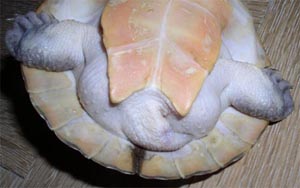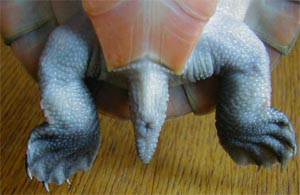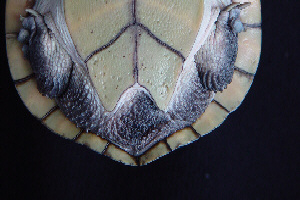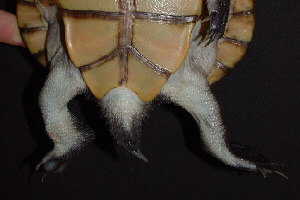

Differentiating male and female Emydura Species
by Jan Matiaska.
 The
Emydura males and females are sexually dimorphic with the most
obvious character being the tail. An observed specimen must be at least
10-12 cm of the carapace length if one wants to identify its gender by just
looking at it. A specimen with such carapace length is 2-3 years old by
then and starts to show secondary gender characteristics. These include
the size and length of the tail, position of the cloaca and the overall
size. There is no colour sexual dimorphism in Emydura, Elseya,
Chelodina or Macrochelodina genera.
The
Emydura males and females are sexually dimorphic with the most
obvious character being the tail. An observed specimen must be at least
10-12 cm of the carapace length if one wants to identify its gender by just
looking at it. A specimen with such carapace length is 2-3 years old by
then and starts to show secondary gender characteristics. These include
the size and length of the tail, position of the cloaca and the overall
size. There is no colour sexual dimorphism in Emydura, Elseya,
Chelodina or Macrochelodina genera.
The photo on the right shows the tail of a female Emydura subglobosa
subglobosa (3 years old, 13 cm carapace length). The tail is relatively
small and even when straighten out, the tip of the tail rarely reached the
carapace rim. When the tail is pulled against one of the thighs, the tip
of it reaches the second marginal scute at most (counted from the tail root).
The anal notch is much deeper than that of a male.
Apart from the tail, the other morphological character that can be used
to sex Chelidae in general is the size of a particular animal.
In general, mature females are bigger than males, are deeper in the shell
(to be able to produce and carry eggs), and are broader in the head. On
contrary, males tend to be smaller, with their carapaces more flat and their
heads more pointy (if looked at from above).
 The
photo on the left shows the tail of a semi adult male Emydura subglobosa
subglobosa (3 years old, 15 cm carapace length). By this stage the
tail is much bigger (longer and thicker) than that of a female with the
ventral opening being located behind the edge of its carapace. The size
of the tail is important for successful copulation. When the tail is withdrawn,
it extends to three in semi-adult males and over four or more marginal scutes
in mature males. The anal notch is not necessarily as deep as that of females.
The
photo on the left shows the tail of a semi adult male Emydura subglobosa
subglobosa (3 years old, 15 cm carapace length). By this stage the
tail is much bigger (longer and thicker) than that of a female with the
ventral opening being located behind the edge of its carapace. The size
of the tail is important for successful copulation. When the tail is withdrawn,
it extends to three in semi-adult males and over four or more marginal scutes
in mature males. The anal notch is not necessarily as deep as that of females.
"The precloacal part of the tail, which accommodates the penis, is almost
always deeper, longer and in general more heavily developed in males than
in females." (Legler & Georges, 1993).
 The
photo to the right shows the tail of a juvenile male Emydura subglobosa
subglobosa (1 and 1/2 years old, 10 cm of carapace length). At this
stage the tail accelerates its growth and the ventral opening is already
pushed further out behind the outer rim of the carapace. The base of the
tail is beginning to get thicker while the anal notch is maintained relatively
shallow. Of course, at this stage some errors in sexing may occur, but the
probability of correct sexing done by an experienced person is very high.
The
photo to the right shows the tail of a juvenile male Emydura subglobosa
subglobosa (1 and 1/2 years old, 10 cm of carapace length). At this
stage the tail accelerates its growth and the ventral opening is already
pushed further out behind the outer rim of the carapace. The base of the
tail is beginning to get thicker while the anal notch is maintained relatively
shallow. Of course, at this stage some errors in sexing may occur, but the
probability of correct sexing done by an experienced person is very high.
 Sexing
specimens of Chelodina and Macrochelodina genera is very
much the same as sexing specimens of the Emydura or Elseya
genera. The tail represents the main differentiating factor. The picture
on the left side shows an adult female of Chelodina mccordi. The
tail is small with its ventral opening close to the tail root. The anal
notch formed by the anal plastron scutes is relatively deep.
Sexing
specimens of Chelodina and Macrochelodina genera is very
much the same as sexing specimens of the Emydura or Elseya
genera. The tail represents the main differentiating factor. The picture
on the left side shows an adult female of Chelodina mccordi. The
tail is small with its ventral opening close to the tail root. The anal
notch formed by the anal plastron scutes is relatively deep.
The photo provided by Oliver Roemp.
 The
photo on the right side shows an adult male of Chelodina mccordi. The tail
is robust and much longer than that of the female. The cloaca is located
further out behind the carapace rim. Please notice the difference between
the female and the male concerning the carapace/plastron position. While
the female's carapace exceeds (overlaps) the specimen's plastron (anal scutes),
the male's carapace is more or less in line with the specimen's plastron.
The
photo on the right side shows an adult male of Chelodina mccordi. The tail
is robust and much longer than that of the female. The cloaca is located
further out behind the carapace rim. Please notice the difference between
the female and the male concerning the carapace/plastron position. While
the female's carapace exceeds (overlaps) the specimen's plastron (anal scutes),
the male's carapace is more or less in line with the specimen's plastron.
The photo provided by Oliver Roemp.
Related articles:
Differentiating Male and Female Chelodina and Macrochelodina Species by Oliver Roemp
Differentiating Male and Female Elseya Species by Darrell Senneke and Scott Thomson